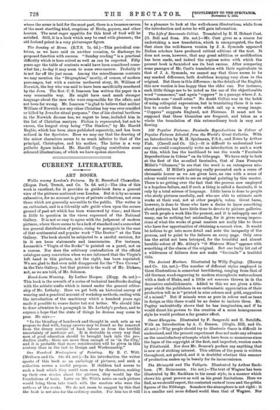100 Popular Pictures: Facsimile Reproductions in Colour of Popular Pictures
Selected from the World's Great Galleries. With an Introduction by M. H. Spielmann, F.S.A., and Notes by Arthur Fish. (Cassell and Co. 12s.)—It is difficult to understand how any one could complacently write an introduction to such a work as this, which has the hardihood to use the words "Facsimile Reproductions in Colour" on its title-page. We have only to look at the first of the so-called facsimiles, that of Jean Fra.ncoia Millet's "Gleaners," to see that the word is an outrageous mis- statement. If Millet's painting really presented such a scene of chromatic horror as we are given here, no one with a sense of colour would ever wish to see an original painting by this master. There is no getting over the fact that the process now employed is a hopeless failure, and if such a thing is called a facsimile, it is only by a total misuse of language. Little harm is done to people who study pictures carefully, and who are able to estimate such works at their real, not at other people's, value. Great harm, however, is done to those who have a desire to know something about pictures, but have little time to devote to picture galleries. To such people a work like the present, and it is unhappily one of many, can be nothing but misleading, for it gives wrong impres- sions of what the works of great masters are really like to those who have few opportunities of obtaining a correct view. It would be tedious to go into more detail and note the incapacity of the process, and to point to the failures on every page. Only once has the artist not been betrayed, for the beautiful and almost heraldic colour of Mr. Abbey's "0 Mistress Mine" appears with something of the charm of the original. But one lucky hit out of a wilderness of failures does not make "facsimile" a. truthful title.


































































 Previous page
Previous page